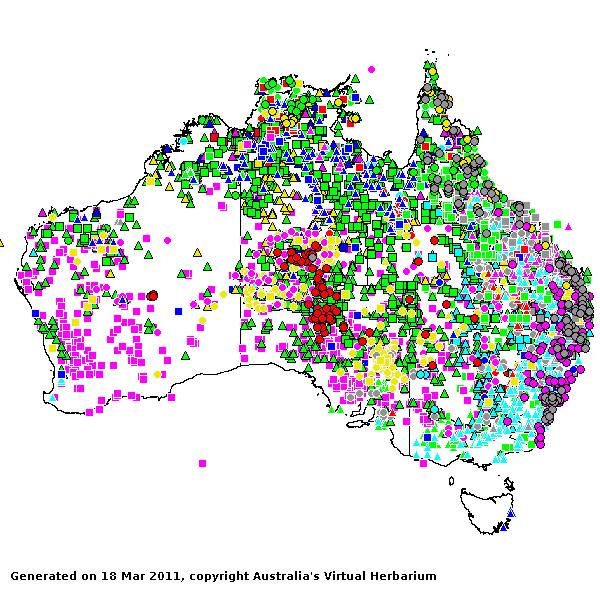Aristida L.,. Sp. Pl. 82 (1753).
Derivation:.
From Latin arista (awn), alluding to the awned lemma.
Taxonomic
revisions, nomenclatural references:. M.Lazarides, Brunonia 3:
271–333 (1980); B.K.Simon, Aust. Syst. Bot. 5: 129–226 (1992).
Key references
(keys and floras):. G.Bentham, Flora Australiensis 7: 560–564 (1878)
and 571–572 (Streptachne); C.A.Gardner, Flora of Western Australia
1 Gramineae 163–169 (1952); E.E.Henty, Manual Grasses New
Guinea 29 (1969); M.Lazarides, Tropical Grasses S.E. Asia 149–150
(1980); M.Lazarides, Flora of Central Australia 448–453 (1981);
J.C.Tothill and J.B.Hacker, Grasses of Southern Queensland 102–109
(1983); B.K.Simon, Flora of South Australia 4: 1872–1877 (1986);
B.K.Simon, Flora of the Kimberley Region 1122–1127 (1992); B.K.Simon, Key
to Australian Grasses 67–72 (1993); S.W.L.Jacobs and S.M.Hastings, Flora
of New South Wales 4: 506–514 (1993); N.G.Walsh, Flora of Victoria
2: 549–552(1994); D.I.Morris, Student's Flora of Tasmania 4B:
322–323 (1994); E.Edgar and H.E.Connor, Flora of New Zealand 5: 503–506
(2000); D.Sharp and B.K.Simon, AusGrass (2002); K.Mallet (ed.), Flora
of Australia 44B: Poaceae 3: 71–118 (2005); J.P.Jessop, Grasses
of South Australia 317–329 (2006); S.W.L.Jacobs, R.D.B.Whalley &
D.J.B.Wheeler, Grasses of New South Wales, 4th Ed, 123–133 (2008).
W.D.Clayton &
S.A.Renvoize, Genera Graminum (1986), genus (299).
Native. 290 species,
from temperate and subtropical regions. 59 species in Australia, WA, NT, SA,
Qld, NSW, Vic, and Tas. Also New Guinea, Malesia and New Zealand.
Habit. Annual
or perennial, tufted. Leaf blades narrow. Ligule a fringed membrane to a fringe
of hairs.
Inflorescence.
Inflorescence paniculate, a spike-like panicle or an open panicle with branches
ending in single spikelets, open or contracted.
Spikelets.
Spikelets laterally compressed to subterete, 1 flowered, with 1 fertile floret,
awned, solitary, pedicelled. Fertile spikelets laterally compressed or
subterete, disarticulating above glumes.
Glumes. Glumes
relatively large, unequal to more or less equal, shorter than spikelet or about
equal to spikelet, usually pointed, awned or awnless, keeled, dissimilar or
similar (membranous to papery). Lower glume 1–7 nerved. Upper glume 1 nerved
(usually) or 3–5 nerved (rarely).
Florets.
Fertile florets 1. Lemmas narrow, cylindrical, convolute or involute, decidedly
firmer than glumes, becoming indurated to not becoming indurated (leathery to
indurated), entire at apex, awned, with a clear germination flap, 1–3 nerved,
hairy (rarely) or glabrous or scabrous. Awns 3-branched (usually) or not
brached (the column sometimes absent, the lateral branches sometimes reduced or
absent), 1 (3 branched), apical, non-geniculate, hairless (usually glabrous),
much shorter than body of lemma to much longer than body of lemma, deciduous or
persistent. Palea conspicuous and relatively short or very reduced (enclosed by
the lemma), entire, thinner than lemma (hyaline), 1 nerved or 2 nerved or
nerveless. Callus long, pointed. Lodicules when present, 2. Stamens 1–3. Grain
small to large (3–11 mm long), fusiform, longitudinally grooved (when lemma
involute) or not grooved, compressed dorsiventrally or terete. Hilum short, or
long-linear. Embryo large (one third grain length), with one scutellum bundle.
Kranz Anatomy.
C4, biochemical type NADP-ME (3 species).
2n = 22,
24, 36, 44, 48, and 66, 2, 4, and 6 ploid.
Habitat.
Mesophytic to xerophytic.
Classification.
Aristidoideae.
Notes. A large
homogeneous genus. Following Simon (1992) the genus in Australia is represented
by the sections Streptachne (3 species), Arthratherum (2
species), Perniciosae (1 species), Calycinae (16 species), Aristida
(24 species) and Macrocladae (6 species). Three other sections are
represented outside Australia.
Types Species. A.
adscensionis L.
Biogeographic
Element. Clifford & Simon 1981, Simon & Jacobs 1990: Gondwanan.


